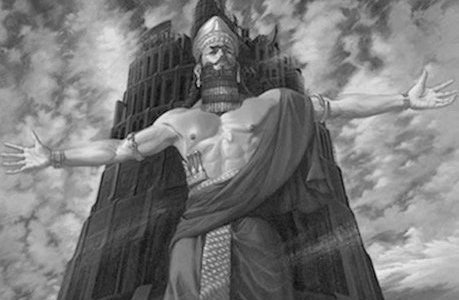 According to Genesis 11:2, Babel was located on “a plain in the land of Shinar.” This region, later known as Babylonia or Mesopotamia, has been called the “Cradle of Civilization.” It was here that the Garden of Eden was found and that human civilization originated, a fact attested to by all reputable archeologists and historians. It was also here that Nimrod, whose name means, "let us rebel," and who was the earth's earliest post-flood rebel, began his mutiny against Deity, by leading fallen man's initial attempt, both in defiance of God and in total independence from God, to build his own heaven on earth and his own way into Heaven. As the site of man’s original sin and expulsion from Eden, as well as the incubator of fallen man’s aspirations toward manmade utopia, this strategic spot carries great symbolic significance in Scripture.
According to Genesis 11:2, Babel was located on “a plain in the land of Shinar.” This region, later known as Babylonia or Mesopotamia, has been called the “Cradle of Civilization.” It was here that the Garden of Eden was found and that human civilization originated, a fact attested to by all reputable archeologists and historians. It was also here that Nimrod, whose name means, "let us rebel," and who was the earth's earliest post-flood rebel, began his mutiny against Deity, by leading fallen man's initial attempt, both in defiance of God and in total independence from God, to build his own heaven on earth and his own way into Heaven. As the site of man’s original sin and expulsion from Eden, as well as the incubator of fallen man’s aspirations toward manmade utopia, this strategic spot carries great symbolic significance in Scripture.
With the lone exception of Jerusalem, Babylon is the most talked about city in the Bible. It serves throughout Scripture as the antitype of Jerusalem. For instance, Jerusalem, which is called “the bride, the Lamb’s wife” (Revelation 19:9-10), depicts the capital of the Kingdom of God, whereas Babylon, which is called “the great whore” (Revelation 17:1-5; 19:2), depicts the capital or center of operation for the kingdom of this world. Although ancient Babylon perished long ago, never to be rebuilt (Jeremiah 50:35-40; 51:25-29, 61-64), its typology lives on in each ensuing age wherever the political, economic, cultural and religious center of the world is found. For instance, in Peter’s day, it was Rome, as is proven by the apostle’s reference to the church in Rome as “the church in Babylon” (1 Peter 5:13).
In the Scripture, Jerusalem is called the “city of God” (Psalm 46:4; 48:1, 8; 87:3; 101:8; Revelation 3:12). It is a “heavenly” city (Hebrews 11:16) built by God (Hebrews 11:10) for the glory of His name (Deuteronomy 12:5, 11, 14, 18, 21; 2 Chronicles 6:4-6). Although the earthly city of Jerusalem serves as a type of the heavenly city, it is not to be confused with that which it symbolizes; namely, the Kingdom of God. Unfortunately, today’s foremost school of eschatology, premillennialism, often exalts Biblical types (the earthly city of Jerusalem) to synonymity with their truths (the heavenly city of Jerusalem); thus, confusing the two and leading Christians to chase shadows rather than the spiritual substance the shadows are meant to merely silhouette.
The Bible describes Babylon in a number of ways. It refers to it as “great” or the “great city” (Daniel 4:30; Revelation 14:8; 16:19; 17:18; 18:2, 10, 16, 18, 19, 20). It calls it “the jewel” and “queen of kingdoms” (Isaiah 13:9; 47:5). It identifies it as “the glory of the Babylonians’ pride” and as “the praise of the whole earth” (Isaiah 47:5; Jeremiah 51:41). Obviously, such glowing descriptions are from the world’s perspective and not heaven’s, which sees Babylon as evocative of fallen man’s attempts at forging his own way to heaven (false religions) and creating his own heaven on earth (one world government). Although Babylon was the first great Gentile world power and the birthplace of false religion, it is not to be confused with that which it symbolizes; namely, the kingdom of this world.